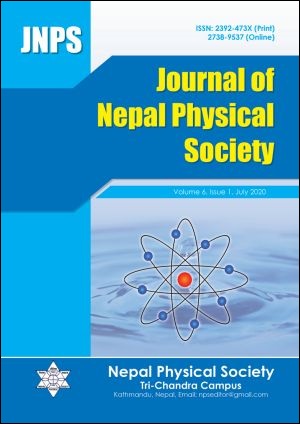Computational Study of the Structural, Electronic and Magnetic Properties of Nanoclusters of Cu2O and CuO: Ab-Initio Approach
DOI:
https://doi.org/10.3126/jnphyssoc.v6i1.30523Keywords:
Density of States, Magnetic moments, Nanoclusters, Semi-metals, Binding energyAbstract
The structural, electronic and magnetic properties of the nanoclusters of (Cu2O) n= 1, 2, 3 and (CuO) m = 2, 4, 6 have computationally studied. Density Functional Theory incorporated in Atomistic tool kit (ATK-DFT) calculators with exchange-correlation functional (SGGA+U) based ab-initio approach is applied for simulation and calculation of these nanoclusters. In the computational study, the nanoclusters (Cu2O)1, (Cu2O)3 , (CuO)2 and (CuO)6 show semiconducting behavior whereas (Cu2O)2 and (CuO)4 show semi-metallic behaviors. The nanoclusters (Cu2 O)1 and (Cu2O)3 show diamagnetic, (Cu2O)2 and (CuO)4 show ferromagnetic, (CuO)2 and (CuO)6 show antiferromagnetic behaviors. The magnetic moments 0.28μB and 0.03 μB are observed in the nanoclusters (Cu2O)2 and (CuO)4 while others are found to be as nonmagnetic . The total energy of nanoclusters have found to be decreasing towards total minimum energy with increasing number of atoms of copper oxides. The nanoclusters (Cu2O) n = 1, 2, 3 and (CuO) m = 2, 4, 6 are used in various applications as in the synthesis of technological materials. The analysis of the effects of bond length and binding energy with the size of nanoclsters have been presented.
Downloads
Downloads
Published
How to Cite
Issue
Section
License
All right reserved. No part of this Journal may be reproduced in any form or by any electronic or mechanical means, including information storage and retrieval system, without permission in writing from the publisher, except by a reviewer who may quote brief passage in a review. The views and interpretation in this journal are those of author(s) and they are not attributable to the NPS.




